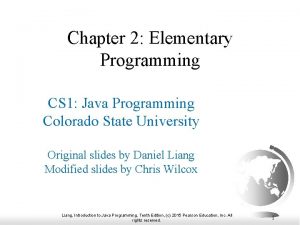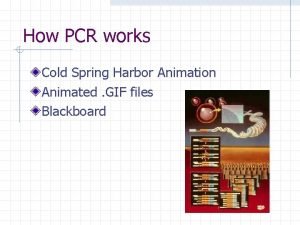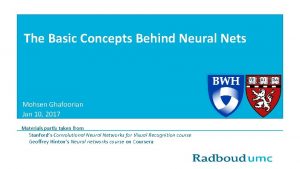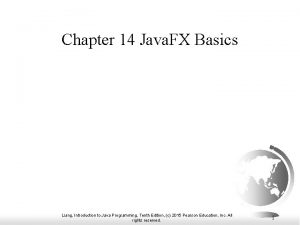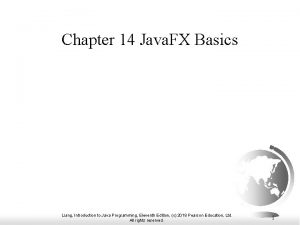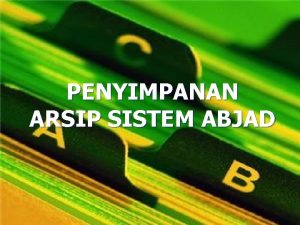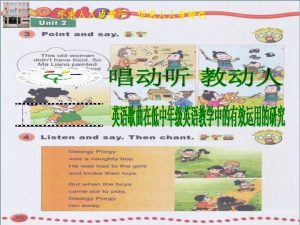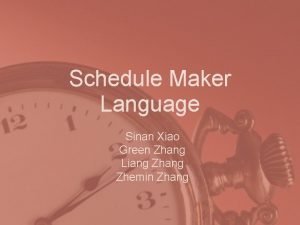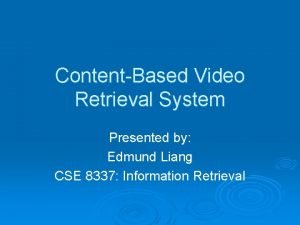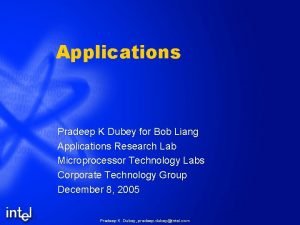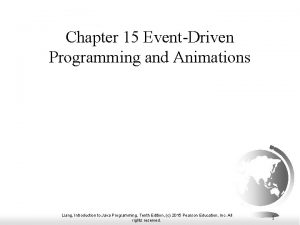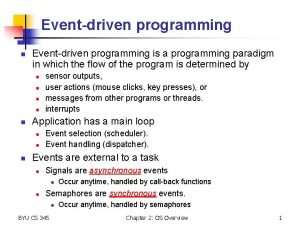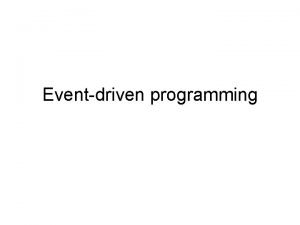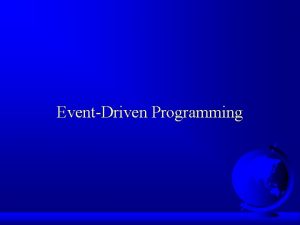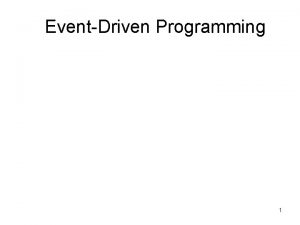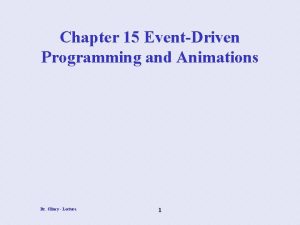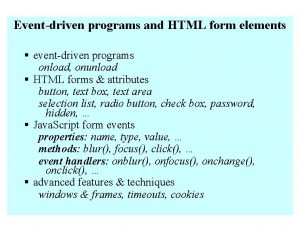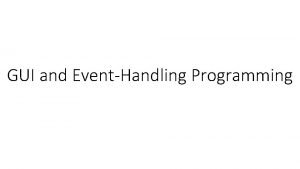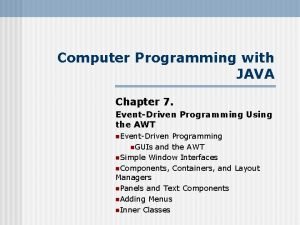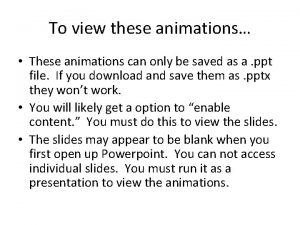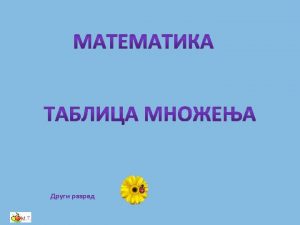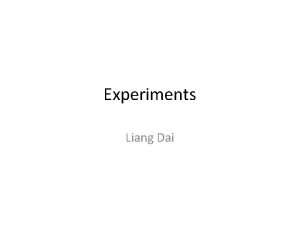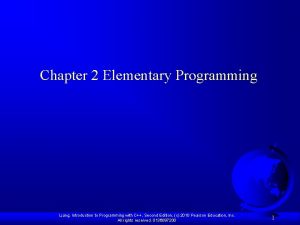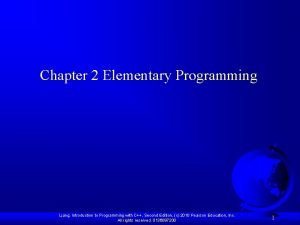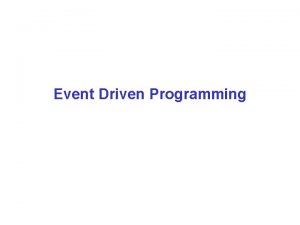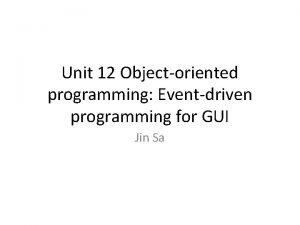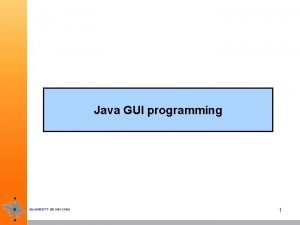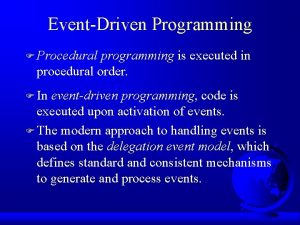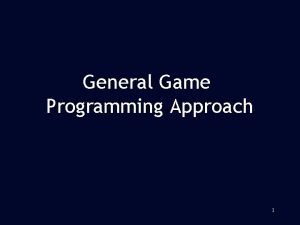Chapter 15 EventDriven Programming and Animations Liang Introduction








































- Slides: 40

Chapter 15 Event-Driven Programming and Animations Liang, Introduction to Java Programming, Eleventh Edition, (c) 2018 Pearson Education, Ltd. All rights reserved. 1

Motivations Suppose you want to write a GUI program that lets the user enter a loan amount, annual interest rate, and number of years and click the Compute Payment button to obtain the monthly payment and total payment. How do you accomplish the task? You have to use eventdriven programming to write the code to respond to the buttonclicking event. Loan. Calculator Liang, Introduction to Java Programming, Eleventh Edition, (c) 2018 Pearson Education, Ltd. All rights reserved. Run 2

Objectives § § § To get a taste of event-driven programming (§ 15. 1). To describe events, event sources, and event classes (§ 15. 2). To define handler classes, register handler objects with the source object, and write the code to handle events (§ 15. 3). To define handler classes using inner classes (§ 15. 4). To define handler classes using anonymous inner classes (§ 15. 5). To simplify event handling using lambda expressions (§ 15. 6). To develop a GUI application for a loan calculator (§ 15. 7). To write programs to deal with Mouse. Events (§ 15. 8). To write programs to deal with Key. Events (§ 15. 9). To create listeners for processing a value change in an observable object (§ 15. 10). To use the Animation, Path. Transition, Fade. Transition, and Timeline classes to develop animations (§ 15. 11). To develop an animation for simulating a bouncing ball (§ 15. 12). Liang, Introduction to Java Programming, Eleventh Edition, (c) 2018 Pearson Education, Ltd. All rights reserved. 3

Procedural vs. Event-Driven Programming § Procedural programming is executed in procedural order. § In event-driven programming, code is executed upon activation of events. Liang, Introduction to Java Programming, Eleventh Edition, (c) 2018 Pearson Education, Ltd. All rights reserved. 4

Taste of Event-Driven Programming The example displays a button in the frame. A message is displayed on the console when a button is clicked. Handle. Event Run Liang, Introduction to Java Programming, Eleventh Edition, (c) 2018 Pearson Education, Ltd. All rights reserved. 5

Handling GUI Events Source object (e. g. , button) Listener object contains a method for processing the event. Liang, Introduction to Java Programming, Eleventh Edition, (c) 2018 Pearson Education, Ltd. All rights reserved. 6

animation Trace Execution public class Handle. Event extends Application { 1. Start from the public void start(Stage primary. Stage) { main method to … create a window and OKHandler. Class handler 1 = new OKHandler. Class(); display it bt. OK. set. On. Action(handler 1); Cancel. Handler. Class handler 2 = new Cancel. Handler. Class(); bt. Cancel. set. On. Action(handler 2); … primary. Stage. show(); // Display the stage } } class OKHandler. Class implements Event. Handler<Action. Event> { @Override public void handle(Action. Event e) { System. out. println("OK button clicked"); } } Liang, Introduction to Java Programming, Eleventh Edition, (c) 2018 Pearson Education, Ltd. All rights reserved. 7

animation Trace Execution public class Handle. Event extends Application { 2. Click OK public void start(Stage primary. Stage) { … OKHandler. Class handler 1 = new OKHandler. Class(); bt. OK. set. On. Action(handler 1); Cancel. Handler. Class handler 2 = new Cancel. Handler. Class(); bt. Cancel. set. On. Action(handler 2); … primary. Stage. show(); // Display the stage } } class OKHandler. Class implements Event. Handler<Action. Event> { @Override public void handle(Action. Event e) { System. out. println("OK button clicked"); } } Liang, Introduction to Java Programming, Eleventh Edition, (c) 2018 Pearson Education, Ltd. All rights reserved. 8

animation Trace Execution public class Handle. Event extends Application { 3. The JVM invokes public void start(Stage primary. Stage) { the listener’s handle … method OKHandler. Class handler 1 = new OKHandler. Class(); bt. OK. set. On. Action(handler 1); Cancel. Handler. Class handler 2 = new Cancel. Handler. Class(); bt. Cancel. set. On. Action(handler 2); … primary. Stage. show(); // Display the stage } } class OKHandler. Class implements Event. Handler<Action. Event> { @Override public void handle(Action. Event e) { System. out. println("OK button clicked"); } } Liang, Introduction to Java Programming, Eleventh Edition, (c) 2018 Pearson Education, Ltd. All rights reserved. 9

Events q An event can be defined as a type of signal to the program that something has happened. q The event is generated by external user actions such as mouse movements, mouse clicks, or keystrokes. Liang, Introduction to Java Programming, Eleventh Edition, (c) 2018 Pearson Education, Ltd. All rights reserved. 10

Event Classes Liang, Introduction to Java Programming, Eleventh Edition, (c) 2018 Pearson Education, Ltd. All rights reserved. 11

Event Information An event object contains whatever properties are pertinent to the event. You can identify the source object of the event using the get. Source() instance method in the Event. Object class. The subclasses of Event. Object deal with special types of events, such as button actions, window events, mouse movements, and keystrokes. Table 15. 1 lists external user actions, source objects, and event types generated. Liang, Introduction to Java Programming, Eleventh Edition, (c) 2018 Pearson Education, Ltd. All rights reserved. 12

Selected User Actions and Handlers Liang, Introduction to Java Programming, Eleventh Edition, (c) 2018 Pearson Education, Ltd. All rights reserved. 13

The Delegation Model Liang, Introduction to Java Programming, Eleventh Edition, (c) 2018 Pearson Education, Ltd. All rights reserved. 14

The Delegation Model: Example Button bt. OK = new Button("OK"); OKHandler. Class handler = new OKHandler. Class(); bt. OK. set. On. Action(handler); Liang, Introduction to Java Programming, Eleventh Edition, (c) 2018 Pearson Education, Ltd. All rights reserved. 15

Example: First Version for Control. Circle (no listeners) Now let us consider to write a program that uses two buttons to control the size of a circle. Control. Circle. Without. Event. Handling Run Liang, Introduction to Java Programming, Eleventh Edition, (c) 2018 Pearson Education, Ltd. All rights reserved. 16

Example: Second Version for Control. Circle (with listener for Enlarge) Now let us consider to write a program that uses two buttons to control the size of a circle. Control. Circle Run Liang, Introduction to Java Programming, Eleventh Edition, (c) 2018 Pearson Education, Ltd. All rights reserved. 17

Inner Class Listeners A listener class is designed specifically to create a listener object for a GUI component (e. g. , a button). It will not be shared by other applications. So, it is appropriate to define the listener class inside the frame class as an inner class. Liang, Introduction to Java Programming, Eleventh Edition, (c) 2018 Pearson Education, Ltd. All rights reserved. 18

Inner Classes Inner class: A class is a member of another class. Advantages: In some applications, you can use an inner class to make programs simple. An inner class can reference the data and methods defined in the outer class in which it nests, so you do not need to pass the reference of the outer class to the constructor of the inner class. Show. Inner. Class Liang, Introduction to Java Programming, Eleventh Edition, (c) 2018 Pearson Education, Ltd. All rights reserved. 19

Inner Classes, cont. Liang, Introduction to Java Programming, Eleventh Edition, (c) 2018 Pearson Education, Ltd. All rights reserved. 20

Inner Classes (cont. ) Inner classes can make programs simple and concise. An inner class supports the work of its containing outer class and is compiled into a class named Outer. Class. Name$Inner. Class. Name. class. For example, the inner class Inner. Class in Outer. Class is compiled into Outer. Class$Inner. Class. class. Liang, Introduction to Java Programming, Eleventh Edition, (c) 2018 Pearson Education, Ltd. All rights reserved. 21

Inner Classes (cont. ) q An inner class can be declared public, protected, or private subject to the same visibility rules applied to a member of the class. q An inner class can be declared static. A static inner class can be accessed using the outer class name. A static inner class cannot access nonstatic members of the outer class Liang, Introduction to Java Programming, Eleventh Edition, (c) 2018 Pearson Education, Ltd. All rights reserved. 22

Anonymous Inner Classes q q An anonymous inner class must always extend a superclass or implement an interface, but it cannot have an explicit extends or implements clause. An anonymous inner class must implement all the abstract methods in the superclass or in the interface. An anonymous inner class always uses the no-arg constructor from its superclass to create an instance. If an anonymous inner class implements an interface, the constructor is Object(). An anonymous inner class is compiled into a class named Outer. Class. Name$n. class. For example, if the outer class Test has two anonymous inner classes, these two classes are compiled into Test$1. class and Test$2. class. Liang, Introduction to Java Programming, Eleventh Edition, (c) 2018 Pearson Education, Ltd. All rights reserved. 23

Anonymous Inner Classes (cont. ) Inner class listeners can be shortened using anonymous inner classes. An anonymous inner class is an inner class without a name. It combines declaring an inner class and creating an instance of the class in one step. An anonymous inner class is declared as follows: new Super. Class. Name/Interface. Name() { // Implement or override methods in superclass or interface // Other methods if necessary } Liang, Introduction to Java Programming, Eleventh Edition, (c) 2018 Pearson Education, Ltd. All rights reserved. 24

Anonymous Inner Classes (cont. ) Anonymous. Handler. Demo Run Liang, Introduction to Java Programming, Eleventh Edition, (c) 2018 Pearson Education, Ltd. All rights reserved. 25

Simplifying Event Handing Using Lambda Expressions Lambda expression is a new feature in Java 8. Lambda expressions can be viewed as an anonymous method with a concise syntax. For example, the following code in (a) can be greatly simplified using a lambda expression in (b) in three lines. Liang, Introduction to Java Programming, Eleventh Edition, (c) 2018 Pearson Education, Ltd. All rights reserved. 26

Basic Syntax for a Lambda Expression The basic syntax for a lambda expression is either (type 1 param 1, type 2 param 2, . . . ) -> expression or (type 1 param 1, type 2 param 2, . . . ) -> { statements; } The data type for a parameter may be explicitly declared or implicitly inferred by the compiler. The parentheses can be omitted if there is only one parameter without an explicit data type. Liang, Introduction to Java Programming, Eleventh Edition, (c) 2018 Pearson Education, Ltd. All rights reserved. 27

Single Abstract Method Interface (SAM) The statements in the lambda expression is all for that method. If it contains multiple methods, the compiler will not be able to compile the lambda expression. So, for the compiler to understand lambda expressions, the interface must contain exactly one abstract method. Such an interface is known as a functional interface, or a Single Abstract Method (SAM) interface. Anonymous. Handler. Demo Liang, Introduction to Java Programming, Eleventh Edition, (c) 2018 Pearson Education, Ltd. All rights reserved. Run 28

Problem: Loan Calculator Loan. Calculator Run Liang, Introduction to Java Programming, Eleventh Edition, (c) 2018 Pearson Education, Ltd. All rights reserved. 29

The Mouse. Event Class Mouse. Event. Demo Liang, Introduction to Java Programming, Eleventh Edition, (c) 2018 Pearson Education, Ltd. All rights reserved. Run 30

The Key. Event Class Key. Event. Demo Run Liang, Introduction to Java Programming, Eleventh Edition, (c) 2018 Pearson Education, Ltd. All rights reserved. 31

The Key. Code Constants Liang, Introduction to Java Programming, Eleventh Edition, (c) 2018 Pearson Education, Ltd. All rights reserved. 32

Example: Control Circle with Mouse and Key Control. Circle. With. Mouse. And. Key Run Liang, Introduction to Java Programming, Eleventh Edition, (c) 2018 Pearson Education, Ltd. All rights reserved. 33

Listeners for Observable Objects You can add a listener to process a value change in an observable object. An instance of Observable is known as an observable object, which contains the add. Listener(Invalidation. Listener listener) method for adding a listener. Once the value is changed in the property, a listener is notified. The listener class should implement the Invalidation. Listener interface, which uses the invalidated(Observable o) method to handle the property value change. Every binding property is an instance of Observable. Property. Demo Run Display. Resizable. Clock Run Liang, Introduction to Java Programming, Eleventh Edition, (c) 2018 Pearson Education, Ltd. All rights reserved. 34

Animation Java. FX provides the Animation class with the core functionality for all animations. Liang, Introduction to Java Programming, Eleventh Edition, (c) 2018 Pearson Education, Ltd. All rights reserved. 35

Path. Transition. Demo Run Flag. Rising. Animation Run Liang, Introduction to Java Programming, Eleventh Edition, (c) 2018 Pearson Education, Ltd. All rights reserved. 36

Fade. Transition The Fade. Transition class animates the change of the opacity in a node over a given time. Fade. Transition. Demo Liang, Introduction to Java Programming, Eleventh Edition, (c) 2018 Pearson Education, Ltd. All rights reserved. Run 37

Timeline Path. Transition and Fade. Transition define specialized animations. The Timeline class can be used to program any animation using one or more Key. Frames. Each Key. Frame is executed sequentially at a specified time interval. Timeline inherits from Animation. Timeline. Demo Run Liang, Introduction to Java Programming, Eleventh Edition, (c) 2018 Pearson Education, Ltd. All rights reserved. 38

Clock Animation Clock. Animation Run Liang, Introduction to Java Programming, Eleventh Edition, (c) 2018 Pearson Education, Ltd. All rights reserved. 39

Case Study: Bouncing Ball. Pane Bounce. Ball. Control Liang, Introduction to Java Programming, Eleventh Edition, (c) 2018 Pearson Education, Ltd. All rights reserved. Run 40
 Daniel liang introduction to java programming
Daniel liang introduction to java programming Pengertian animasi dalam multimedia
Pengertian animasi dalam multimedia Impulse-style scroll animations
Impulse-style scroll animations Pcr animations
Pcr animations Make animation google photos
Make animation google photos Loffe animations
Loffe animations Impact motion tween
Impact motion tween Chapter 1 introduction to computers and programming
Chapter 1 introduction to computers and programming Computer programming chapter 1
Computer programming chapter 1 Chapter 1 introduction to computers and programming
Chapter 1 introduction to computers and programming C programming chapter 1
C programming chapter 1 Richard seow yung liang
Richard seow yung liang Zhuo shi wo li liang
Zhuo shi wo li liang Zhong hanliang
Zhong hanliang Yuanxing liang
Yuanxing liang Amber liang
Amber liang Liang fontdemo.java
Liang fontdemo.java Liang fontdemo.java
Liang fontdemo.java Penyimpanan sistem abjad
Penyimpanan sistem abjad Zachary hensley
Zachary hensley David teo choon liang
David teo choon liang How was ma liang like?
How was ma liang like? Zong-liang yang
Zong-liang yang Liang jianhui
Liang jianhui Google zhang liang games
Google zhang liang games Chia liang cheng
Chia liang cheng Administrasi keuangan kelas 11
Administrasi keuangan kelas 11 Mechanical engineering umbc
Mechanical engineering umbc Zong-liang yang
Zong-liang yang Dr liang hao nan
Dr liang hao nan Dr liang hao nan
Dr liang hao nan Pengertian arsip menurut para ahli
Pengertian arsip menurut para ahli Anticorps anti nucléaire moucheté 1/160
Anticorps anti nucléaire moucheté 1/160 Kathleen liang
Kathleen liang Edmund liang
Edmund liang Perbezaan salur darah
Perbezaan salur darah Sushil dubey intel
Sushil dubey intel Diana liang faa
Diana liang faa Foo joon liang
Foo joon liang Perbedaan linear programming dan integer programming
Perbedaan linear programming dan integer programming Greedy vs dynamic programming
Greedy vs dynamic programming
